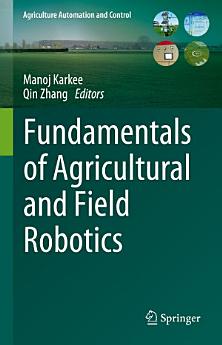Fundamentals of Agricultural and Field Robotics
この電子書籍について
This book aims at presenting the fundamental principles of various aspects of automation and robotics as they relate to production agriculture (the branch of agriculture dealing with farming operations from field preparation to seeding, to harvesting and field logistics). The building blocks of agricultural automation and robotics that are discussed in the book include sensing and machine vision, control, guidance, manipulation and end-effector technologies. The fundamentals and operating principles of these technologies are explained with examples from cutting-edge research and development currently going on around the word. This book brings together scientists, engineers, students and professionals working in these and related technologies to present their latest examples of agricultural automation and robotics research, innovation and development while explaining the fundamentals of the technology. The book, therefore, benefits those who wish to develop novel agricultural engineering solutions and/or to adopt them in the future.
著者について
Dr. Manoj Karkee is an Associate Professor in the Biological Systems Engineering Department at Washington State University (WSU) and is the co-director of WSU-University of Technology Sydney joint center on #AgRobotics. He was born and raised in eastern hills of Nepal. He received his diploma in Civil Engineering and undergraduate in Computer Engineering from Tribhuvan University, Nepal. His MS was in remote sensing and GIS from Asian Institute of Technology, Thailand and his PhD was in Agricultural Engineering and Human Computer Interaction from Iowa State University. Dr. Karkee leads a strong research program in the area of sensing, machine vision and #AgRobotics at the WSU Center for Precision and Automated Agricultural Systems (CPAAS). He has published more than 65 peer-reviewed journal articles, and more than 25 referred conference papers. He has also been awarded two US patents, and has published one book (edited) and eight book chapters. Dr. Karkee is currently serving as an elected chair for International Federation of Automatic Control (IFAC) Technical Committee on ‘Control in Agriculture’, as an associate editor for ‘Transactions of the ASABE’, as a guest editor for ‘Sensors’, and an Adjunct Professor for Zhejiang University in China. Dr. Karkee was recognized as ‘2019 Pioneer in Artificial Intelligence and IoT’ by Connected World magazine and was featured as the ‘Western Innovator’ by Capital Press.
Qin Zhang
Dr. Qin Zhang is the Director of the Center for Precision and Automated Agricultural Systems (CPAAS) of Washington State University (WSU), and a Professor of Agricultural Automation in the Department of Biological Systems Engineering, WSU. His research interests are in the areas of agricultural automation, agricultural robotics, and off-road equipment mechatronics. Prior to his current position, he was a faculty member at the University of Illinois at Urbana-Champaign, worked at Caterpillar Inc., and taught at Zhejiang Agricultural University in China. Based on his research outcomes, he has authored/edited seven books, written more than a dozen separate book chapters, edited three conference proceedings, published over 180 peer reviewed journal articles, and been awarded 11 U.S. patents. He is currently serving as the Editor-in-Chief for Computers and Electronics in Agriculture. Dr. Qin Zhang received his B.S. degree in engineering from Zhejiang Agricultural University, China; M.S. degree from the University of Idaho and Ph.D. degree from the University of Illinois at Urbana-Champaign. Dr. Qin Zhang is an ASABE Fellow and is serving or served as a guest or an adjunct professor for 9 other universities.







